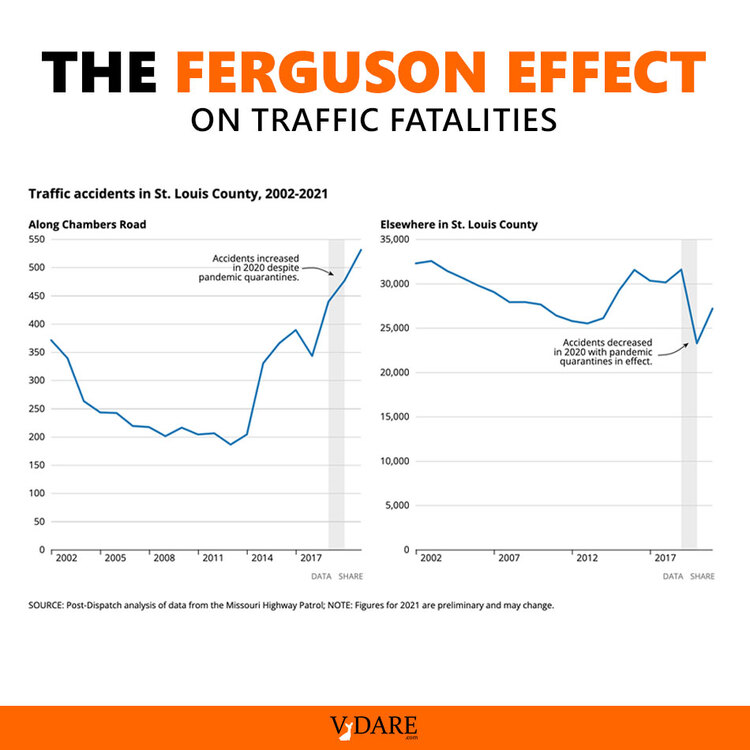
ST. LOUIS POST-DISPATCH: "St. Louis’ Deadly Traffic Crisis Isn’t That Complicated. Enforce the Law."
By Steve Sailer
02/26/2024
As I’ve been pointing out since 2016, St. Louis has had a big traffic fatality problem due to, first, the Ferguson Effect.

From WPDE.com:
Man accused of killing mother, daughter in crash after Drake show in Missouri out on bail
by JESSICA A. BOTELHO | The National DeskMon, February 26th 2024 at 1:23 PMST. LOUIS, Mo. (TND) — A 22-year-old man accused of speeding through a red light and killing a mother and her daughter as they were leaving a Drake concert in Missouri was released on bond, court documents show.
Monte Henderson was released from jail Friday morning after posting $20,000, which was 10% of his $200,000 bail, according to court records.
GRAPHIC: Man accused of killing a mother and her daughter after St. Louis concert.
— The Post Millennial (@TPostMillennial) February 26, 2024
The St. Louis Post-Dispatch editorial board argues:
Editorial: St. Louis’ deadly traffic crisis isn’t that complicated. Enforce the law.
The Editorial Board Feb 20, 2024 25
There are some issues in government that are so complex that even assessing the problem is difficult, let alone solving it.
St. Louis’ traffic fatality crisis isn’t one of those issues.
The problem is that too many drivers routinely speed, run red lights and break other traffic laws with impunity because they know the city’s understaffed and overwhelmed police force has effectively stopped enforcing those laws.
The solution is to start enforcing those laws, even if that requires hiring more cops (and it does).
It’s really not that complicated: Pull. Them. Over.
The latest victims of this continuing, maddening refusal by city political leaders to carry out a fundamental municipal function are Laticha Bracero, 42, and Alyssa Cordova, 21. The Chicago mother and daughter were in St. Louis last week for a Drake concert at Enterprise Center downtown.
As the two were walking a few blocks from the arena, a Jeep speeding through an intersection struck multiple vehicles and hit and killed both women.
The driver, Monte Henderson, 22, of Kirkwood, faces involuntary manslaughter charges. Security cameras in the area showed the Jeep traveling at about 70 mph and running a red light before the crash.
If that sounds like an insane level of recklessness in a tight urban setting, it is — but it’s not at all unusual. Anyone who lives downtown or spends much time there can attest that revving engines, screeching tires and blown red lights are commonplace throughout the area.
What’s not common is seeing anyone pulled over for it. Or, for that matter, seeing much police presence at all, other than during major entertainment events or on weekend nights along Washington Avenue.
The data bear out the sense of lawlessness. As the Post-Dispatch reported last year, city police made half as many traffic stops in 2021 as in 2009 — a period during which St. Louis saw annual traffic fatalities roughly double. The cause and effect couldn’t be more obvious.
The message has been received loud and clear by the city’s most reckless drivers: There will be no consequences for their recklessness unless they happen to crash and/or kill someone.
Even drivers with every motive to keep their heads down know they don’t have to because getting pulled over for even flagrant traffic violations is so rare.
They include the driver with a revoked license who sped through a red light last February at the intersection at South Grand Boulevard and Forest Park Avenue, causing a crash that killed four people.
And they include the driver that same month who had violated his bond on a robbery charge more than 50 times but was nonetheless out and speeding around downtown, causing a crash that took both the legs of a teenage volleyball player visiting from Tennessee.
After last week’s tragedy, Mayor Tishaura O. Jones called reckless driving “an urgent and immediate issue” and vowed to press ahead with her program to create “traffic calming” infrastructure like speed bumps and roundabouts to force drivers to slow down.
Voicing urgency from City Hall is appropriate, and traffic calming measures should be part of the solution. But why do comments by Jones and other city leaders so glaringly fail to focus on the lack of traffic enforcement and the emboldening effects that has on traffic scofflaws?
Maybe because once that topic is acknowledged, they would be expected to do something about it, with the most obvious first step being to increase headcount in the city’s dangerously understaffed police department.
As of last fall, there were fewer than 950 sworn officers on a force with about 1,275 budgeted positions. No wonder police aren’t able to address any but the most serious crimes.
The challenges of a tight labor market — as well as the fact that part of Jones’ political base is still dedicated to the discredited and counterproductive “defund the police” movement — make adding police more difficult than it should be.
But until Jones and her allies confront that challenge and get enough officers onto the streets to get them under control, too many drivers will continue to believe they can zoom recklessly around the city with no fear of being pulled over. Because it will continue being true.
